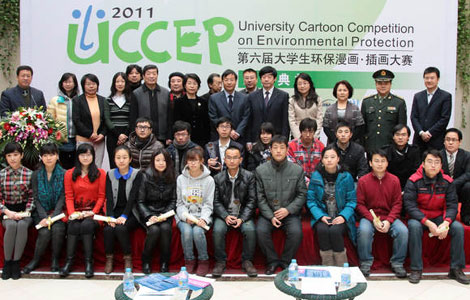The right chemistry for pharma firms
Updated: 2012-01-09 09:40
By Liu Jie (China Daily)
|
|||||||||
Overseas pharmaceutical firms are conducting more research in China as the country's medical market expands and the West's health sector shrinks
NANJING - It took preliminary talks lasting more than a year, innumerable onsite investigations and seemingly endless negotiations, but all the effort ultimately led to a contract covering hundreds of pages.
|
 |
|
A pharmaceutical exhibition in Nanjing, Jiangsu province. An increasing number of multinational pharmaceutical companies are eyeing the Chinese market as part of their global R&D chains. [Photo/China Daily] |
That intensive groundwork resulted in cooperation between the international pharmaceutical company Bristol-Myers Squibb Co (BMS) and the Jiangsu-based Simcere Pharmaceutical Group, who in December 2010 reached a strategic partnership to co-develop an oncology compound (the creation and development of a cancer treatment).
One year later, with research and development (R&D) into the compound still at an early stage, BMS announced that it will expand the strategic partnership to tap a new area - cardiovascular diseases.
Unlike their previous sales-centered strategies, an increasing number of multinational pharmaceutical companies are eyeing the Chinese market as part of their efforts to boost their global R&D chains.
In 2011, BMS also established R&D collaborations with Wuxi AppTec Co Ltd for stability studies into small-molecule new-chemical entities and with Crown Bioscience Inc on the development of cancer treatments.
BMS is not the only international drugmaker actively seeking R&D cooperation with Chinese companies. A number of overseas businesses have enthusiastically embraced the idea of conducting joint R&D, especially with biopharmaceutical companies.
Pfizer Inc, the world's largest drugmaker by sales, has entered into collaboration with MicuRx Pharmaceuticals Inc, a Chinese biopharmaceutical company specializing in the development of antibiotics to treat drug-resistant bacteria, and with Cumencor Pharmaceuticals Inc to discover therapeutic agents for multi-drug-resistant tuberculosis (MDR-TB).
Merck Sharp & Dohme Corp (MSD) - known in the United States and Canada as Merck & Co, the world's second-largest drug producer by sales - recently reached a deal with Shenzhen-based BGI (formerly known as Beijing Genome Institute) to combine the research institute's sequencing and bioinformatics capabilities with MSD's expertise in drug development to identify a new generation of personalized therapies.
Chinese companies will benefit from collaborative partnerships with the multinationals that are exploring new approaches to advancing the clinical development of innovative products in China, on sound molecular pipelines (the number of products under development), extensive experience in R&D management, strong funding support and global R&D resources, said Guo Fanli, an analyst from China Investment Consulting Co Ltd.
Meanwhile, international drugmakers may benefit from rich clinical trial resources, locally tailored products for Chinese patients, technological support for their global R&D networks, cost reductions and easier access to registration and approval, Guo said.
However, challenges exist for both sides, such as cultural differences, analysts said.
Moving to China
Flat demand for medicines and the sluggish economic conditions in developed markets have prompted many multinationals to move their R&D activities to China.
Pfizer closed its R&D facility in the United Kingdom in early 2011, resulting in job losses for more than 2,400 engineers. Meanwhile, Novartis International AG announced in April 2011 that it will cut nearly 550 jobs at its UK R&D center by 2014. Both companies have recently increased their R&D capabilities in China. Pfizer set up its second facility in Wuhan, in Hubei province, in October, to complement an earlier facility in Shanghai. The new unit, where 200 staff will be employed by the end of this year, is also a platform for Pfizer to conduct cooperation with local companies, academic institutes and universities.
At the end of 2010, Novartis AG said it would invest $1 billion in China within five years to enhance its R&D strength in cancer treatments, and its local partners will be engaged in helping to increase efficiency in the research and commercialization of the products.
According to Liu Xue, a professor at the Guanghua School of Management at Peking University, the comparative slowdown in sales of medicines in developed markets means that it makes little economic sense to continue R&D investment in those countries.
According to the international healthcare market researcher IMS Health Inc, China became the world's third-largest pharmaceutical market in 2010. Sales of medicines are predicted to grow 25 to 27 percent year-on-year to exceed $50 billion in 2011. The researcher forecast that the market will grow at an average annual rate of 20.1 percent to reach 694 billion yuan ($110 billion) by 2015.
Apart from the size of the market, foreign companies are also drawn by China's rapidly improving R&D environment, said Liu, adding that cooperation with local partners allows companies to develop locally tailored products and make it easier for them to get industry registration and approval for their research activities.
The biopharmaceutical industry is one of seven strategic sectors for which the Chinese government has promised support in its 12th Five-Year Plan (2011-2015). The country, with the goal of becoming a major research hub in the international pharmaceutical sector, has already allocated 105 billion yuan to key drug-creation programs, launched to support local R&D projects with a view to developing 30 new treatments in 10 major therapeutic areas by 2020.
That government support has prompted overseas companies to further tap into the sector. However, Lydia Xu, a researcher on the pharmaceutical sector with the Samsung Economic Research Institute, said that the majority of the funds will be invested in State-owned researchers or academic institutes and universities.
Although cooperation with Chinese companies will not allow multinationals to access the funding, the domestic environment, which favors biopharmaceutical development, is a bonus in obtaining registration and commercialization approvals for treatments, analysts said.
Jean-Christophe Pointeau, president of BMS China, said that the company had to take registration and approval issues into consideration. Meanwhile, the higher price of self-developed drugs in the Chinese market was also an important element when the company decided to focus on self-developed medicines rather than high-quality generic products.
The ongoing reforms to China's healthcare system have focused on lowering drug prices and healthcare costs in general. Prices should be lower for generic drugs, because they require no technological innovation. However, "for a new innovation-originated product or a specific therapy for a serious disease, for example cancer, a higher price is acceptable, because the cost of R&D is high and it (the medicine) can save lives and bring benefits to the public", said Pointeau.
Related Stories
R&D Achievements 2011-07-17 09:35
Support for R&D increases 2011-04-15 06:18
Microsoft to add R&D staff 2011-07-28 09:51
AkzoNobel ups R&D in China 2011-06-14 08:05
Obama : le système d'immigration américain a besoin d'une réforme réelle et globale 2011-05-11 10:04
Toyota to invest $700m in China for R&D 2010-11-18 14:58
- Regional free trade talks in the pipeline
- China market retained auto sales crown
- The right chemistry for pharma firms
- Yum! takeover proposal approved
- Financial regulators to minimise systemic risks
- No room at the inn for some test-takers
- Chinese tourists flocking to neighbor
- Nationwide rush for home kicks off









